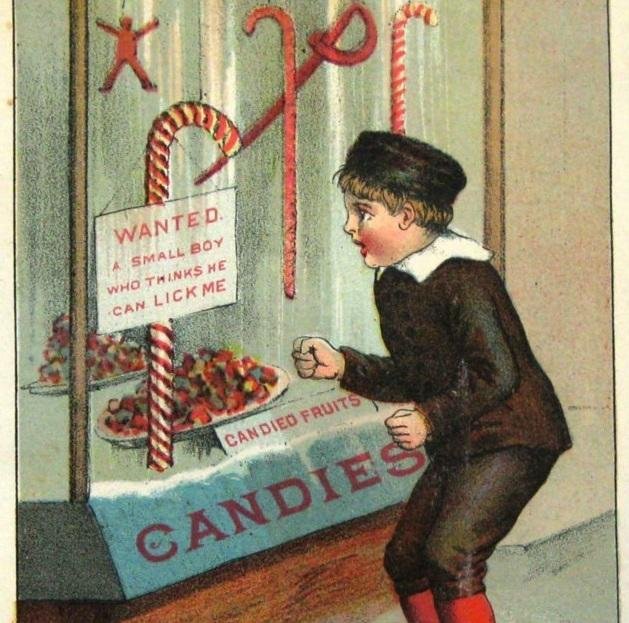
A quick look back over 350 years into the history of the holiday treat, they didn’t always look like they do now.
The story goes that in 1670 a choirmaster in Cologne, Germany wanted to keep the children quiet during the long nativity crèche service. He asked the local candy maker to create some long lasting sweet sticks for him to pass out to silence the little brats.
To stop any questions about him handing out the candies in church, he asked that they be bent into a crook to resemble the ones the shepherds had when they visited dear eight pound, six ounce newborn baby Jesus in his golden, fleece diaper (I like the baby version the best, do you hear me?! I’m writing the article and I get to choose the words!).

It also turned it into the shape of a 'J', convenient to relate it to 'J'esus and these early canes were also all white, said to represent his sinless life. Well, it went over so well that the practice began to spread and the candy cane became associated with Christmas.
The first mention of candy canes in America is from 1847 when a German immigrant decorated his Christmas tree with them.
No one knows exactly when or why, but around the year 1900 the red stripes were added to candy canes as well as adding the now traditional peppermint flavoring. The red coming to mean the blood that Jesus shed for our sins.

The problem with producing the candy canes was that the canes had to be bent by hand, and breakage rates ran in the 20% range. Not only that, but they were pretty fragile and these problems led to candy canes only being produced by local confectioners.
This was solved by the invention of an automatic candy cane production machine by a Catholic priest named Gregory Keller. He invented it in 1957 for his brother-in-law and business started booming thanks to the machine. The company was called Bobs Candies, and is still in business today.
Now I should mention that the history of the candy cane before the 20th century is mainly just best guesses as no one wrote down much about a little holiday candy treat. It does seem reasonable enough though.
Bonus Facts:

Candy canes are made from sugar, corn syrup and flavoring. The normal flavor is peppermint, but you can find them in nearly any flavor if you look hard enough, even bacon.
A standard (medium) sized cane is 6 inches long, 3/8ths of an inch wide and runs about 60 calories.
Candy canes are wrapped before they are bent.
About 1.76 billion candy canes are produced each year and they are almost all sold between Thanksgiving and Christmas.
The largest candy cane ever created was made by candy shop owner Paul Ghinelli in 2001. It measured 58ft and 2.25 inches (17.74 meters) and required over 900 pounds of sugar.
Sources:
- 9 things you didn't know about candy canes
- The History of Candy Canes
- Candy cane
- Pictures: 1 Gif 3 4
My moment of honesty:
- My interests vary but I strive for quality work, check my blog for proof.
- I will not fill up your feed with crap, I have only resteemed twice.
- I will also reply to all your comments if they warrant any reply.
- These things I promise to you. So follow me, or don't. I want you to do what you want to.
@getonthetrain
Looks around for @lordvader
Your statement, "The first mention of candy canes in America is from 1847 when a German immigrant decorated his Christmas tree with them" was interesting to me because my family has always included candy canes in our Christmas tree decor, and we have a lot of German ancestors. Now I'm wondering if the man who seemingly started the practice in America is one of them!
Well, it was invented and spread out from Germany - so could be. The man I mentioned lived in a town in Ohio.
BACON BACON BACON
Im beggin for BACON!
thats what my face looks like when I think of bacon candy canes
Thanks. Interesting to know this. Like you also do a story about French Fries did not come from the French? ;-)
French? Oui!

Maybe the choirmaster was Krampus in disguise, my friend! :)
I haven't seen it, I know everyone was watching it last year around this time but I heard it wasn't so good so I passed. Worth a watch or naw?
It's OK, bro... Not a great movie, but the original legend itself is much cooler!
This post has been ranked within the top 80 most undervalued posts in the second half of Dec 10. We estimate that this post is undervalued by $9.54 as compared to a scenario in which every voter had an equal say.
See the full rankings and details in The Daily Tribune: Dec 10 - Part II. You can also read about some of our methodology, data analysis and technical details in our initial post.
If you are the author and would prefer not to receive these comments, simply reply "Stop" to this comment.